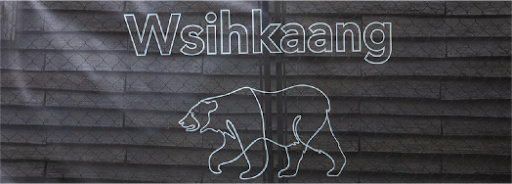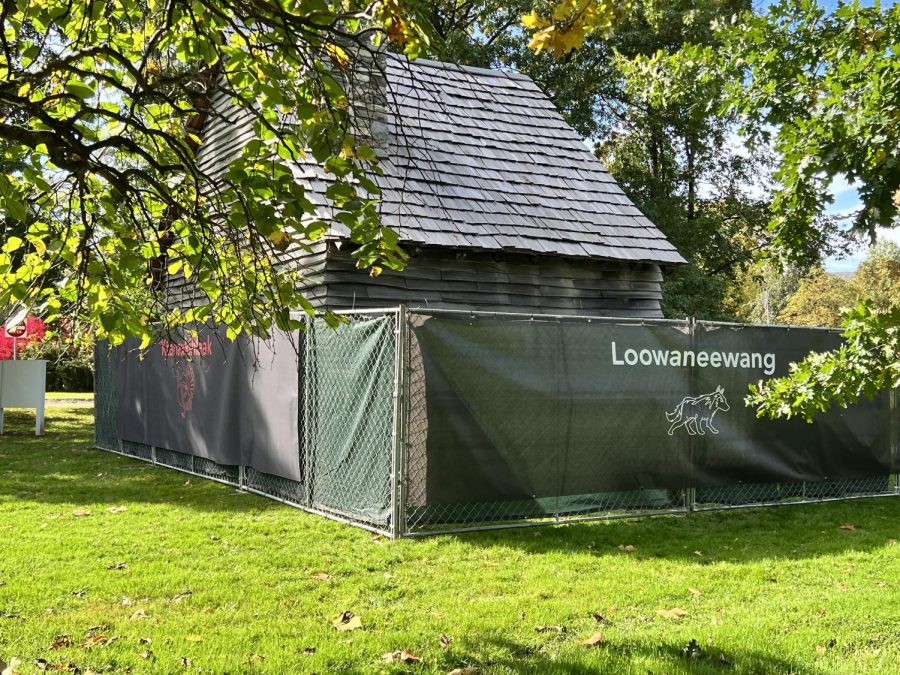Anonymous artist installs exhibit at Williamstown’s 1753 House
October 20, 2021
On Indigenous Peoples’ Day, an anonymous artist installed an art display partially obscuring Williamstown’s 1753 House, a replica of a settler home located in Field Park. The installation represents the history of Indigenous communities in Williamstown and will stay up until Oct. 29, during which time the 1753 House will be inaccessible to the public.
The installation emerged from a conversation between Outreach Manager at the ’62 Center for Theatre and Dance Randal Fippinger and Assistant Vice President for Campus Engagement Bilal Ansari, both affiliates of the Williamstown Diversity, Inclusion, Racial Equity Committee (DIRE), and Christina Yang, who is a curator at the Williams College Museum of Art (WCMA).
Installed by the artist in a week and a half, the unnamed art display covers all sides of the 1753 House using a black mesh fabric resting atop a chain fence. It is designed with the Mohican cardinal directions of a compass — Ktanaxkihlaak (Eastern Door), Shaawaneewang (Southern Door), Wsihkaang (Western Door), and Loowaneewang (Northern Door) — accompanied by the family clan animals — turkey, turtle, bear, and wolf — of the Stockbridge-Munsee Community.
The sign introducing the 1753 House, which was created to celebrate the Town’s 1953 bicentennial, has also been covered by a banner that depicts a reimagined Town flag lacking the 1753 House and text. A small QR code accompanies the exhibit, leading visitors to the Stockbridge-Munsee Community website.
It is unknown if the artist is affiliated with the College or the Stockbridge-Munsee Community. “[The artist’s] preference is to stay as anonymous as possible,” Yang said.
The artist spoke directly to the Stockbridge-Munsee Community, which supported the project, according to Fippinger. “None of us wanted to do this without getting their OK,” he said.
The history between the Stockbridge-Munsee Community and the College is a long one, and one involving colonization, stolen property, and displacement. Ephraim Williams Sr., the father of the College’s founder, was directly involved in the displacement of the Stockbridge-Munsee Mohican people. The College launched a collaboration effort with the tribe earlier this year by funding research efforts and helping to establish the Stockbridge-Munsee Historic Preservation Office.
The main goal of the installation was to inspire a deeper conversation about the location’s history. “The artist is trying to have us imagine a community without the European settlers,” Fippinger wrote in an email to the Record. “I’ve heard some people saying this is trying to cancel the 1753 House; quite the contrary — the artwork doesn’t work if you cancel the 1753 House. It’s meant to be a conversation with it.”
Indeed, the combination of the 1753 House — a symbol of European settlement — with the symbols of the Mohican people alludes to the area’s history of displacement and settler colonialism.

“An artist can actually address these histories,” Yang said. “[Art] can really transform the way you think. And I don’t mean by ‘transform’ like ‘force you to think differently,’ but really just raise consciousness and raise conversation … I think artists do that in an incredibly beautiful and complicated way.”
The installation has certainly sparked discussion within the community, according to Fippinger, on the Williamstown Info and Issues Facebook group. Fippinger said he also received supportive messages from local members of the Indigenous community.
While Yang and Fippinger said that there are not currently any plans for future displays of the same kind, Fippinger said he hopes that the piece will inspire residents and student groups to create similar projects. “I think it is inspiring, now, an annual conversation [on Indigenous People’s Day] … I’d love to do this every year,” he said.









